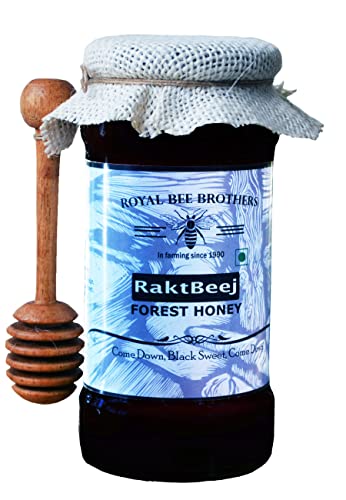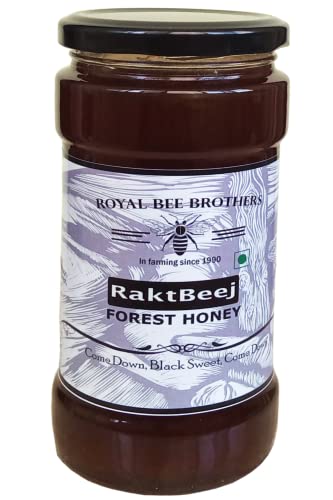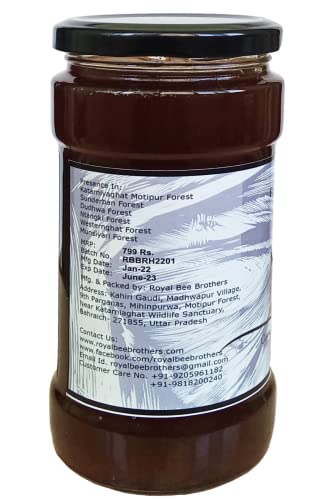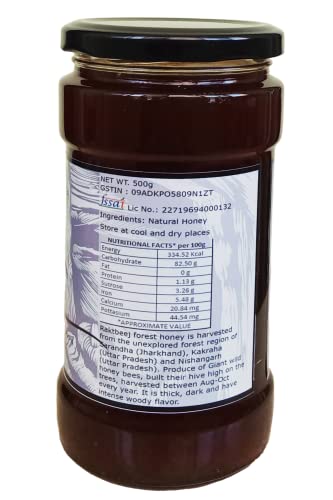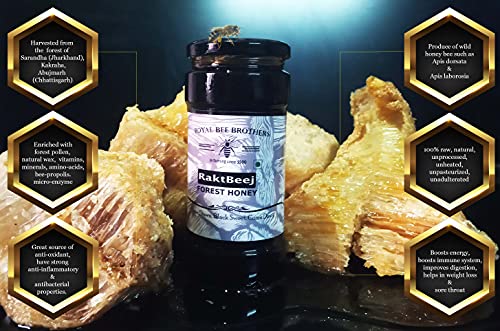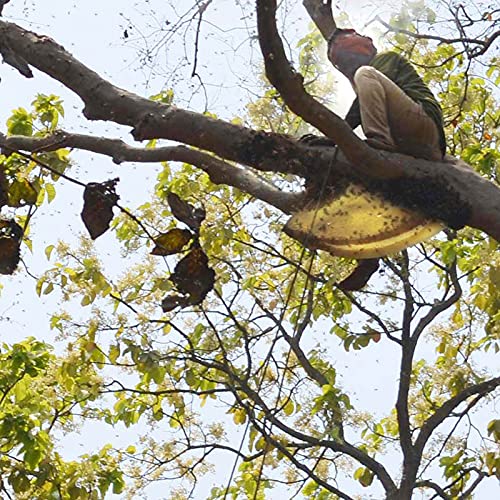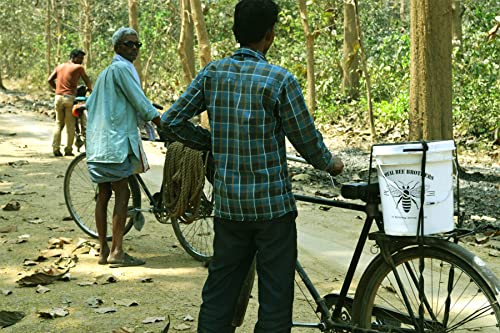Royal Bee Brothers | Raktbeej Forest Honey | NMR Tested Raw Forest Honey |Produce of Giant Wild Honey Bee | Harvested from Saranda Forest , Jharkhand| 100% Raw, Unprocessed, Unheated Honey | 500 g
Product Description
100% Natural, Authentic, Raw & Unprocessed Forest Honey, produce of Wild Honey Bees, known for its traditional mysterious Woody Flavor and Black Color


The High Nutritional and Medicinal Values as well as the Hidden Efforts of our Honey Hunters, makes Raktbeej Raw Honey Absolutely Exceptional
This is one of the best forest honey harvested from the unexplored Saranda forest, a dense forest in the hilly region of West Singhbhum district in the Indian state of Jharkhand. This honey is particularly rare but with good reason, and the story behind it is quite extraordinary. In Saranda forest, giant wild honey bees build their hive high on the trees, local people use to call these honey bees as killer bees. Each honey hive is guarding by 80,000 – 100,000 wild killer honey bees which can carrying kilos of a sticky, black and thick fluid known as honey. This sweet fluid, honey, is real black and thick honey with natural smoky aroma of wild forest.
Honey Connoisseurs Love to Muse about Raktbeej Honey’s Black Color, Flavor, Depth, the Swirl, the Aroma, the Taste and the Finish.


Rich in minerals, natural enzymes and vitamins with a very diversified composition, offers excellent natural remedial and anti-inflammatory properties
Once in a year, for a whole month, the wild honeybees come to gather the nectar from the flowers, to which they turn into honey, making it distinct, unique, tasteful and luscious from the other varieties of honey. This honey is produced by wild honeybees namely Apis dorsata. These large indigenous honeybee species often nest high on cliffs or in high trees. Apis dorsata is an economically important bee species due to the large quantities of honey that it can produce. It is one of the most dangerous animals of the Saranda jungles due to their threatening defensive behavior. The large body size of Apis dorsata allows them to have a greater flight and foraging range than in comparison to other species of honeybees. The aggregations of these bees formed on the tallest trees or cliffs, introduce a major challenge to access. Furthermore, the natural distribution of these bees overlaps with that of tigers, which have been known to kill honey hunters.
Around 50 – 60 honey hive colonies in a tree and Saranda forest is full of such type of nature’s wonder.


The taste, color, texture, aroma, viscosity and various other properties of raw honey varies from season to season.
The bees get their nectar and pollen depends on the season and the available blooming plants in the forest area. In the heart of lush green forests, the blooming plants are not just fresh and in abundance but also 100% organic. This all contributes to how the honey tastes, as well as to its color and texture. When the honeybee is wrestling in a flower collecting nectar and pollen, she gets covered in pollen granules which inevitably find their way into the finished (capped) honey. This pollen not only adds to a honey’s unique characteristics, but it is the traceable indicator, not nectar, to which flowers the honeybee visited during her foraging.


Each drop has been harvested by Royal Bee Brothers team
The bees are driven away with the help of a smoke from the grass that disorients the bees and the honey part of the hive is cut off. Honey collectors are trained to collect honey in a sustainable way so that after a hive is harvested the honeybees return and rebuild the hive at the same place.
Our quality team insures that ground team harvest only those honey hive which are filled & fully sealed.
The pollution and pesticide free forest region of Saranda flourish with thousands of exotic floral species in April/May. It is known as the best honey harvesting season as the honey combs are filled with honey in these months. Honey hunter team camps deep inside the forest at least 7-10 days in advance to start preparing for harvesting by identifying and marking the trees with honey combs. Either ropes or makeshift ladders are used to reach the top of the trees or cliffs and small bundles of dried leaves surrounding wet ones are burnt to create a smoke which drives the bees out off the comb. Honey bees adopt a very peculiar behavior, called defense waves when they sense a potential threat — they raise their wings and create a wave around the hive as an alarm signal. The honey collectors stay still for several minutes along with smoke to calm the bees and reduce their aggression. Traditionally, the honey collection is done on a moonless night to minimize the number of flying bees once the colony is disturbed. The honey hunter harvests only a portion of honey filled chamber, without harming the honey bees so that bees can return back to repopulate the hive for the next season of honey gathering.
It’s pure and natural, delightful and delicious. It’s liquid sunshine.


Honey Hunting is Practiced not only for Economic Gains but it also has Spiritual, Cultural and Social Significance locally.
The harvested honey is manually squeezed out from the honeycombs by separating the honey and wax. In the process of harvesting, we use a normal cotton cloth which removes only hive debris and all the natural goodies like propolis, royal jelly, wax and bee pollen remain in the honey which provide a unique flavor and aroma to it. It is then hygienically filled in the glass bottles. It is done manually, and no plant or machinery is used in the entire process. This adds in making the honey more enriched, nutritious and free from the hazardous effects that can be caused by using soiled and greasy machines.
Honey has tremendous socio-economic value in terms of its use in rituals, social, and health benefits. In Saranda forest, days before the harvest, preparations begin in earnest which articulates a harmonic relationship between people and the nature. Rituals and folklore play an important role, sing to the bees and ask for forgiveness, religious prayers are performed, followed by chanting of mantras, sacrifice of flowers, rice beer and the offering of last season honey to the goddess Vamuna. It is believed that goddess Vamuna protects the honey collectors from wild animals, wild bees and other threats of the forest.
Escape the ordinary adventure with our collection of wide range of natural forest honey harvested from various forest region across India


Royal Bee Brothers – Harvesting Forest Honey Since 1990
Rich in heritage and family history, wild honey harvesting have been our traditional family business since generations. Royal Bee Brothers heritage includes third generations of wild honey harvesting in India, located in dense forest region of Bahraich (Uttar Pradesh). Currently, we have around 10 variety of natural forest honey with different taste and color, harvested from forests such as Abujhmarh, Sundarbans, Motipur, Kaharwa, Kandhamal, Kalahandi, Westernghat and many more. Honey hunters not only collects the forest honey, but also collects stories along the way, his own and of those who join in the hunt, and returns to the village with both of these precious things – one to fill the stomach, and one to fill the soul.
HONEY BEE BREED: The indigenous wild forest bees feed and forage on naturally grown medicinal herbs in the Saranda and Abujmarh forests and collects the nectar of naturally grown wild flower of forest to prepare Raktbeej forest honey.
HARVESTING METHOD: After traditionally extracting the forest honey out of honeycomb, we use cotton cloth to remove only hive debris yet retaining all the natural goodies like royal jelly & bee pollen. Next stage is to manually fill in the glass bottle.
UNADULTERATED: We pledge that this honey is 100% organic, pure and raw honey. There is no sub process involved and no value taken out. It is untreated, unprocessed, unheated, unpasteurized and unfiltered forest honey, free from any type of adulteration.
NATURAL NUTRIENTS: This raw and unprocessed honey provides you with more than just calories. It is a wild bee pollen enriched forest-food which naturally contains Vitamins, Minerals, Amino Acids, Micro-Enzymes, Bee Propolis, Natural Wax & Royal Jelly.
Original price was: ₹799.0.₹719.0Current price is: ₹719.0.
₹799
4.5
Additional Information
| ASIN | B08GYND718 |
|---|---|
| Customer Reviews |
4.3 out of 5 stars |
| Best Sellers Rank | #15,660 in Grocery & Gourmet Foods (See Top 100 in Grocery & Gourmet Foods) #173 in Honey |
| Date First Available | 29 August 2020 |
| Manufacturer | Royal Bee Brothers, Kahiri Gaudi, Madhwapur Village, Motipur Forest, Bahraich- 271855, U.P., +91-9205961182 / 9818200240/ [email protected], Address: Kahiri Gaudi, Madhwapur Village, 9th Parganas, Mihinpurwa, Motipur Forest, Near Katarniaghat Wildlife Sanctuary, Bahraich- 271855, Uttar Pradesh |
| Packer | Royal Bee Brothers, Kahiri Gaudi, Madhwapur Village, 9th Parganas, Mihinpurwa, Motipur Forest, Near Katarniaghat Wildlife Sanctuary, Bahraich- 271855, Uttar Pradesh |
| Item Weight | 500 g |
| Item Dimensions LxWxH | 8 x 5 x 5 Centimeters |
| Generic Name | Forest Honey |
B08GYND718

Original price was: ₹799.0.₹719.0Current price is: ₹719.0.

